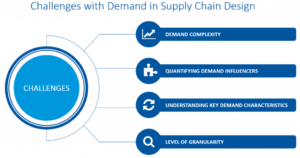 How confident are you in your ability to predict future customer demand? How do external factors such as economics and weather influence that demand next month or next year?? If you’re uncertain how to account for changing demand, how can you confidently design your supply chain to support your customers in the future? Without demand modeling tools you could be leaving significant opportunity on the table, or risking inventory and capacity disasters.
How confident are you in your ability to predict future customer demand? How do external factors such as economics and weather influence that demand next month or next year?? If you’re uncertain how to account for changing demand, how can you confidently design your supply chain to support your customers in the future? Without demand modeling tools you could be leaving significant opportunity on the table, or risking inventory and capacity disasters.
In today’s increasingly competitive and demand-driven marketplace, it’s more critical than ever to understand your customers’ buying behavior as well as have the ability to accurately quantify what factors impact their demand. Why is future demand different than you thought and what components drive these changes? Is it long-term growth that’s changing and how might that impact your long-term capacity planning process? Is there SKU-proliferation? Having the right answers to these questions is significantly more important than the forecast itself as you design your future supply chain.
Demand Modeling Provides an Accurate Picture of Future Demand
 You probably know that demand is a crucial input in supply chain modeling and S&OP activities, but many companies lack confidence in their demand data. This may be due to missing information or “black box” applications that obscure complete and/or accurate calculations. Some analysts feel they don’t have the statistical background to correctly interpret this data even if they do have it on-hand. Demand modeling is emerging as a critical capability for businesses that want a visually interactive way to have more confidence in their demand predictions as well as their ability to make effective supply chain strategic decisions for the future.
You probably know that demand is a crucial input in supply chain modeling and S&OP activities, but many companies lack confidence in their demand data. This may be due to missing information or “black box” applications that obscure complete and/or accurate calculations. Some analysts feel they don’t have the statistical background to correctly interpret this data even if they do have it on-hand. Demand modeling is emerging as a critical capability for businesses that want a visually interactive way to have more confidence in their demand predictions as well as their ability to make effective supply chain strategic decisions for the future.
Here are five reasons you should consider demand modeling in supply chain design:
- Your future supply chain is largely impacted by demand. One of the most important factors that impacts your supply chain is demand. Designing a smart and successful supply chain requires a good understanding of future demand, its components and key drivers.
- Demand modeling allows you to explore and test alternative theories of what causes demand to occur. A deeper understanding of this demand provides higher confidence in design recommendations to better quantify changing trends, detect what stage of life cycle your product is at, and investigate cause and effect relationships between your demand and its influencers using powerful machine learning algorithms.
- Demand modeling drives accurate demand scenarios and sensitivities. Accurately quantifying which factors influence your demand enables you to explore more robust demand scenarios and sensitivities for a better future design state in a “safe” modeled environment prior to implementation.
- Demand modeling supports a repeatable process to capture ongoing changes. Factors that influence demand are dynamic and having a repeatable process to capture the complete view enables better supply chain design.
- Demand modeling eases many of the challenges with demand as part of supply chain design. Barriers such as demand complexity, inability to quantify demand influencers and lack of understanding of key demand characteristics often constrain accurate and effective supply chain designs.
Rapidly changing customer preferences, a competitive marketplace, and unforeseen factors can account for a drastic change in customer demand and quickly derail any supply chain. With the support of solutions like demand modeling, organizations can better prepare for these situations and design the supply chain to meet customer need and beat the competition.
Vikram Srinivasan is Product Manager of Demand Guru at LLamasoft and is primarily responsible for managing the inventory and demand modeling product life cycle, defining and prioritizing market requirements. Vikram’s expertise spans across network and inventory optimization and demand modeling. Prior to his Product Manager role, Vikram worked as a Senior Consultant at LLamasoft on multiple projects solving various supply chain design problems. He received his M.S in Industrial Engineering (Major: Operations Research) at The Ohio State University.


















Leave a Reply